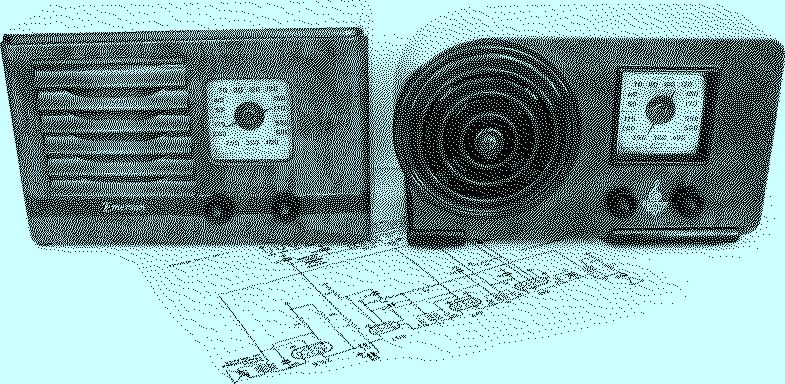|
Another "Little Miracle" Radio AX-217 from 1938 - not designed by Alexis de Sakhnoffsky, but miniaturized by Emerson too, made by Ingraham & Co. too, Serviced and Working
In a Nutshell
It's not the Ugliest Duckling amongst the seven Emerson Radios with AX chassis !

Introduction:
The fairy tale "Den Grimme Ælling" (The Ugly Duckling) by Danish poet Hans Christian (namesake of myself) Andersen comes into my mind when comparing the seven 1938 Emerson radios with AX chassis (235 (catalin), 212 (bulls eye, also for sale), 238 (jewel chest), 211, 217 (this one), 237, 257, the last two being kitchen radios), which is not fair since the 217 is by far not the ugliest. Better matching is the tale "Frau Holle" by Jacob and Wilhelm Grimm, describing the fate of her two daughters "Goldmarie und Pechmarie", when comparing Emerson's AX212 (also for sale) and AX217 (pict.s 27,28, ref.3). Same age, same chassis, made by the very same Ingraham Co. - same radio, were there not designer Alexis de Sakhnoffsky sprinkling gold flakes on the former, causing its value to more than double. The cabinet of the AX217 is straight, "...Frank Lloyd Wright styling rather than deco or streamline modernism ... more Ingraham
cabinets than not look good because of their use of simple vertical or horizonal lines on the face of the cabinet", as justpassin'through of ARF qualifies the difference.
Both radios are midgets (pict. 2) - "less than the size of your hat" (Emerson). To make sure that midget sets didn't have midget sound Emerson had to invent the "Miracle Tone Chamber" - "an amazing device designed on the acoustic principle of the human voice itself, - that creates a new purity, beauty and naturalness of tone. Instead of the monotonous boom of low notes overshadowing the melody, you get the full, true melodic range that gives character to both voice and instrument". Please don't ask me how it works. As all midget radios this radio too faces the problem of large heat dissipation, which Emerson adressed by implementing a resistive power cord (see techies), a device that is rarely found intact today. The power cord, although taped, works fine in this radio. Replacing such a power cord by a regular one may be the reason, that many of these radios have also been separated from their back planes, in order to improve ventilation. The radio for sale here still has its original back plane.
Additional information:
ref.1: http://www.antiqueradio.com (has three examples)
ref.2: http://www.antiqueradioexchange.com/index.php?a=2&b=1261 (refinished, no decal, $215)
ref.3: http://www.pitt.edu/~dash/grimm024.html
About my radio:
The radio is in near mint condition. "Near" refers to the fact that the cabinet has been refinished (water based stain and high gloss laquer, new decal), the (foggy) dial lens replaced, and the Ingraham tag missing. The cabinet has no cracks, hairlines, chips, scratches. The chassis is in perfect condition too, the speaker having no repairs. The radio has a new wire antenna, the resistive power cord (see techies) is still there and works, but is taped at most of its length. The "Gemloid" dial is in perfect condition too. The two knobs are original and in perfect condition. The original back plane has been completed at its upper right corner (pict.4), The 4 feet and most of the patent tag are present (pict.s 13,14). The radio comes with all GT tubes (metal would have been an alternative choice, G-type tubes not, since they are too big to fit into the midget cabinet). The radio plays nicely (see movie by clicking on thumbnail 24), with good sensitivity and selectivity, with the wire antenna extended. Please
e-mail
me (Kris) for any questions, ich spreche Deutsch, je parle Français.
For the techies:
Several smaller size AA5 (All American 5-tube) radios of the late 1930's used tube sets with a high (compared to later designs) 0.3A heater current, the heater voltages of which do not add up to the line voltage of ~120V. The voltages of the Emerson AX217 tubes (see table below and pict.24) add up to ~68V (2x25 + 3x6). A #44 pilot light (6.3V, 250mA) brings the voltage to ~75V, so that the missing ~45V have to be dropped outside the radio in the line cord, which requires a resistance of 150Ω (R10). The pilot bulb is paralleled with a second resistor in the line cord of 40Ω (R9) to protect it from high surge currents. Thus about 12 Watt (or about 40%) heat are taken out of the radio and distributed over the 64" length of the power cord. Pict.s 4 and 22 show the heavily taped but working power cord which gets handwarm, whitewashing its bad reputation as a "curtain burner".
Here are the specifications:
| Technical Description of Item |
| Manufacturer |
Emerson Radio and Phono Corp., New York, USA |
| Model |
AX-217 "Little Miracle" |
| Type |
5-tube AM superheterodyne receiver |
| Production Year |
1938 |
| Serial Number |
AX-2131660 |
| Cabinet |
By Ingraham Co. Bristol from butt walnut |
| Dial |
Cloisonné metal "Gemloid" dial under (new) celluloid lens |
| Knobs |
2 original black bakelite knobs |
| Speaker |
4" field coil speaker under wooden speaker grille |
| Frequency Range |
AM/BC 540 - 1730 kHz |
| Controls |
On/off - volume, tuning |
| Tube line-up |
6A8 (RF), 6K7 (IF), 6Q7 (Det.), 25L6 (AF), 25Z5 (Rect.), all GT type |
| Size (WxDxH) |
9" x 4" (with knobs) x 5½" |
| Weight |
4 pounds = 1.9 kg
|
| Comment |
Undervalued little Emerson radio, serviced and perfectly working |
|




